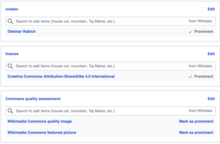|
Wikimedia Commons
Wikimedia Commons, or simply Commons, is a wiki-based media repository of free-to-use images, sounds, videos and other media.[1] It is a project of the Wikimedia Foundation. Files from Wikimedia Commons can be used across all of the Wikimedia projects[2] in all languages, including Wikipedia, Wikivoyage, Wikisource, Wikiquote, Wiktionary, Wikinews, Wikibooks, and Wikispecies, or downloaded for offsite use. As of January 2025, the repository contains over 112 million free-to-use media files, managed and editable by registered volunteers.[3] History
 The idea for the project came from Erik Möller in March 2004[4] and Wikimedia Commons was started on September 7, 2004.[5][6] In July 2013, the number of edits on Commons reached 100,000,000.[7] In 2018, it became possible to upload 3D models to the site in STL format. One of the first models uploaded to Commons was a reconstruction of the Lion of Al-lāt statue in Palmyra, Syria, which was heavily damaged by ISIS in 2015.[8] Various notable organizations have uploaded files to Commons. In 2012, the National Archives and Records Administration uploaded 100,000 digitised images from its collection.[9] In 2020, the Digital Public Library of America (DPLA) started uploading its collections to Commons.[10] In 2022, DPLA uploaded more than two million files.[11] Similarly Europeana, the website aggregating European cultural heritage, shares its digitised images through Commons.[12] During the COVID-19 pandemic, as part of a collaboration with Wikimedia, the World Health Organization (WHO) uploaded its "Mythbusters" infographics to Commons.[13] Relation to sister projectsThe stated aim of Wikimedia Commons is to provide a media file repository "that makes available public domain and freely-licensed educational media content to all, and that acts as a common repository for the various projects of the Wikimedia Foundation."[14] Most Wikimedia projects still allow local uploads which are not visible to other projects or languages, but this option is meant to be used primarily for material (such as fair use content) which local project policies allow, but which would not be permitted according to the copyright policy of Commons. For this reason, Wikimedia Commons deletes copyright violations and aims to only host freely licensed media, such as media licensed with the Creative Commons Attribution and Attribution/ShareAlike licenses,[15] other free content and free software licenses, and public domain media. Controversial contentThe site has been criticized for hosting large amounts of amateur pornography, often uploaded by exhibitionists who exploit the site for personal gratification, and who are enabled by sympathetic administrators.[16] In 2012, BuzzFeed described Wikimedia Commons as "littered with dicks".[17] In 2010, Wikipedia co-founder Larry Sanger reported Wikimedia Commons to the FBI for hosting sexualized images of children known as "lolicon". After this was reported in the media, Jimmy Wales, founder of the Wikimedia Foundation which hosts Commons, used his administrator status to delete several images without discussion from the Commons community. Wales responded to the backlash from the Commons community by voluntarily relinquishing some site privileges, including the ability to delete files.[18] UtilitiesOver time, additional functionality has been developed to interface Wikimedia Commons with the other Wikimedia projects. For instance, there exists a community-maintained Commons Mobile App which allows uploading of photos that document the world, especially notable objects findable in the map in the Nearby List in the app (displaying Wikidata items with coordinates). The app launched in 2012 as an official Wikimedia app and since May 2016, it uses the official Wikimedia Commons name and logo.[citation needed]  Structured Data on Commons (SDC) is a three-year software development project funded by the Sloan Foundation[citation needed] to provide the infrastructure for Wikimedia Commons volunteers to organize data about media files in a consistent manner. This data is structured more and is made machine-readable.[19][20][non-primary source needed] Quality There are three mechanisms on the site for recognizing high-quality works. One is known as "Featured pictures", where works are nominated and other community members vote to accept or reject the nomination. This process began in November 2004. Another process known as "Quality images" began in June 2006, and has a simpler nomination process comparable to "Featured pictures". "Quality images" only accepts works created by Wikimedia users, whereas "Featured pictures" additionally accepts nominations of works by third parties such as NASA. A third image assessment project, known as "Valued images", began on June 1, 2008, with the purpose of recognizing "the most valued illustration of its kind", in contrast to the other two processes which assess images mainly on technical quality. Wikimedia Commons Pictures of the Year The Commons Picture of the Year (POTY) is a competition that runs every year since 2006. It aims to identify the best freely licensed images from Commons submissions, including those that during the year have been awarded Featured picture status.[21][22] Gallery
See also
References
External links |
||||||||||||||||||||||||||
Portal di Ensiklopedia Dunia




